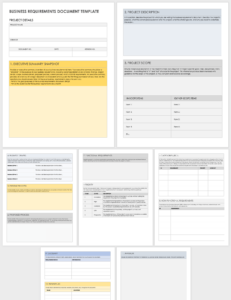Capturing business requirements is a crucial step in any software development project. It ensures that the end product meets the needs of the business and users. Without a clear understanding of the requirements, it is impossible to develop a successful software solution.
There are many different ways to capture business requirements. One common method is to use a template. A template provides a structured way to gather information from stakeholders and ensure that all necessary information is captured. In this article, we will discuss the benefits of using a template to capture business requirements and provide a sample template that you can use for your own projects.
Benefits of Using a Template
There are many benefits to using a template to capture business requirements. First, a template can help to ensure that you gather all of the necessary information from stakeholders. A well-designed template will include prompts for all of the key information that you need, such as the business goals, user needs, and functional requirements.
Second, a template can help to organize the information that you gather. A template will typically include sections for different types of information, such as the business context, the user stories, and the acceptance criteria. This organization can make it easier to find the information that you need and to understand the relationships between different requirements.
Third, a template can help to save time. By using a template, you can avoid having to reinvent the wheel for each new project. You can simply reuse the template that you have already created, which can save you a significant amount of time.
Finally, a template can help to improve communication between stakeholders. By using a shared template, stakeholders can be sure that they are all using the same language and understanding the requirements in the same way. This can help to avoid misunderstandings and misinterpretations.
Sample Template
The following is a sample template that you can use to capture business requirements:
- Project Name:
- Project Description:
- Business Goals: What are the business goals that the project is intended to achieve?
- User Needs: Who are the users of the system and what are their needs?
- Functional Requirements: What are the specific functions that the system must perform?
- Non-Functional Requirements: What are the non-functional requirements of the system, such as performance, security, and usability?
- Acceptance Criteria: How will the system be tested and accepted?
- Stakeholders: Who are the stakeholders in the project and what are their roles?
- Assumptions: What are the assumptions that are being made about the project?
- Constraints: What are the constraints that the project is facing?
This is just a sample template. You can customize the template to fit the specific needs of your project.
Conclusion
Using a template to capture business requirements is a valuable way to ensure that you gather all of the necessary information, organize the information, save time, and improve communication between stakeholders. By using a template, you can help to ensure that your software development project is successful.
In addition to the benefits listed above, using a template can also help to improve the quality of your requirements. By using a structured approach to gathering and organizing requirements, you can help to identify and eliminate errors and inconsistencies. This can lead to a more efficient and effective software development process.

